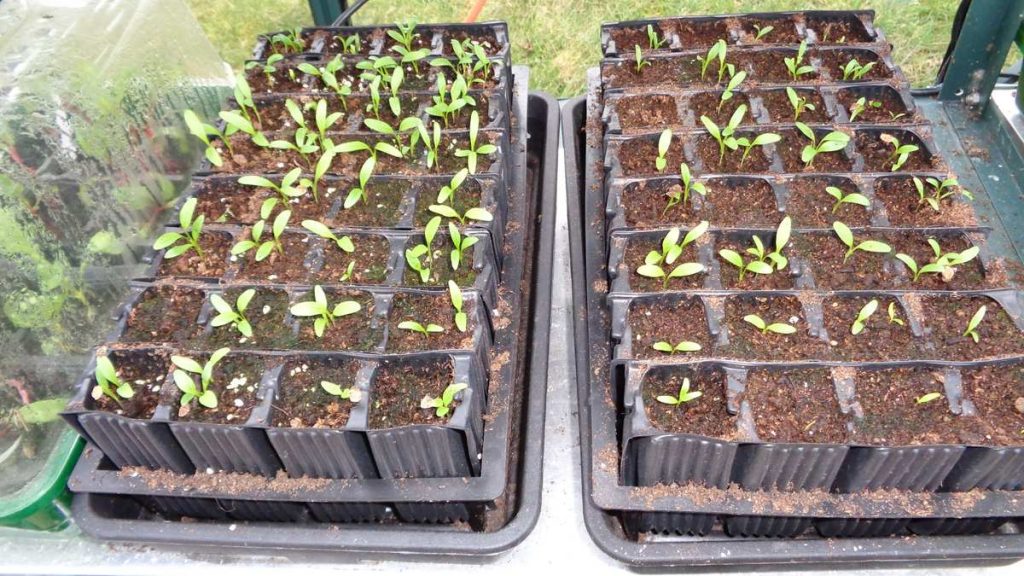Well the results from my parsnip experiment are in and it’s not what I was hoping for. This year, instead of direct sowing, I decided to try starting my parsnips under cover and transplanting.
Parsnip Germination Experiment Worked
First I soaked them in a cinnamon and aspirin solution as an antiseptic germination aid. They were then sown into root trainers with 18ºC bottom heat. Parsnips are famous for being difficult and slow to germinate but with this method I had higher than 80% germination in 4 weeks. So this part of the experiment worked well. I covered the options in this article – Parsnip Germination Tips and Temperatures
What Went Wrong?
The plants were transplanted at 20 cm spacing (8 ins) in a raised bed with deep stone-free soil / compost mix. Pretty much an ideal growing medium.
My technique with the root trainers
Now I think two things went wrong for me, early on. The first was that I didn’t pack the compost tightly into the root trainers thinking that a light compost would assist the seedlings. Possibly it was a bit dry as well. This may be true but it made transplanting without root disturbance more difficult.
When I came to plant out the compost tended to break up and fall off the root. This inevitably caused damage to the root hairs so the plant reacted as if it had been blocked by a stone perhaps and forked.
Delayed planting out
The second thing was the weather when the parsnips germinated. Spring went from warm to cold and around again with snow even in April. This delayed planting out too long and the taproot was starting through the base of the root trainer in some cases. The effect of this was the same as hitting a block and caused forking.
Summer
It may be that the glorious summer worked against me as well. It’s pretty unusual to get long periods without rain here and I was a bit slow to react to the need to water. I think the irregular water availability caused some irregular growth and roots forking. It wasn’t the roots seeking nutrients but water.
The result
What’s really galling is that I’d kept an eye on the parsnips and judging by the shoulders that I could see, expected some really nice large roots. I’d resisted the urge to dig one up and look. There’s nothing you can do when they’re growing anyway.
As we’ve had a couple of frosts, I harvested a couple and, as you can see, a bit of a disaster. As well as so much root forking they’re looking like some monster off Dr Who, some have been badly affected by canker.
Lesson for next year
Next year I’ll definitely start my parsnips undercover on heat. Because the high germination rate and the ability to defeat weed pressure is such a big advantage. If I can avoid the root forking problem it has to be worth it. Rather than root trainers, I’m going to try using toilet roll inners so avoiding root disturbance on planting out.
I can’t control the weather but hopefully we’ll have a more normal year and I can get them into the ground in time.







We had difficulty similar to u when using the training modules. Havent tried with the toilet roll inners but planted straight into soil 3 diff times and places this yr and those pesky mice got the lot (we live in Scotland Angus which us between Dundee and Aberdeen)
All I can say is “good luck”.
I’ve been down both routes. I’m a rootrainer aficionado, almost everything I grow is started in these cells. I have over 100 “sets” long, short and narrow. Bought commercially, because they’re not cheap from garden centres.
They didn’t work for parsnips, for the reasons you gave.
Neither do toilet rolls in my opinion, the slightest disturbance to the tap root tip, causes forking.
Sow under a plank, in early May, in well watered and tilled soil. Check regularly for germination after 17 days onwards.
Thanks for your input – I’ve not heard this idea of covering with a plank before.
Yes, told to me by an “old timer”.
I’ve never had a bad crop, since adopting it. I use old scaffold planks.
The plank serves several purposes. Initially it helps to warm up the soil prior to sowing, just like black plastic I suppose. It then protects the shallowly sown, thin seeds from drying out, if there is a desiccating wind. Alternatively, if there is lots of heavy rain, it prevents them being washed away.
You do need to keep a good eye on them, once the potential germination time is reached. I was caught out one year, and found “cress”, because I failed to look under the planks for 5/6 days.
And although it may rub up against many, slug pellets under the plank are a must. It’s a very happy place (moist and dark), for them to hide.
Station sow every 5”/6”, then thin when seedlings are large enough to handle.
I get great sized, tasty roots, for late Autumn/Winter (not a showbench person). My biggest parsnip problem is canker, but that’s a soil issue that’s hard to eradicate.
This method is widely used in South Wales allotment sites but like you said, you need to check every day or two to make sure they don’t blanch or squash themselves. Have had some great results this way.
Why do you cover them with a plank ?
Hi Adelle,
Please read my reply to John H, above.
this makes interesting reading because I just can’t seem to grow decent parsnips tried paper pots toilet rolls peat pots
but John M method seems to be well worth trying a friend of ours told me to sow my parsnip seed in rows and tip some hot water on the seed when sowing I thought ok but never done it
to my surprise he bought me some of his parsnips they where brilliant then he’s got really good black soil that’s quite deep
then there’s a chap on the allotments that grows his parsnips in a ridge and those are good large parsnips his wife makes parsnip wine he told me he makes a ridge then with a metal bare makes a hole and fills it with compost and sand mix so I though about trying this method next year as well as John M’S you never know we mite just have a parsnip or two
I don’t have particularly good soil – originally heavy clay, but it has been worked as an allotment since 1928, so well cultivated by now. However, I can still dig up huge lumps of solid clay, if I dig down into the second spit. Now there is a well dug and tilled circa 18″. Parsnips don’t like too rich a soil, or recently composted or manured (that’s another reason that causes forking).
I remember when I first got married, we grew parsnips at home in very heavy soil. I banged a straight crowbar into the soil, rotated it to make a cone shaped hole and my wife back filled the hole with sieved soil and peat. I don’t have the energy (or time) to do that now.
The other thing to consider is soil temperature. Don’t sow when the soil hasn’t properly warmed up. This was a classic case this year with “the beast” hitting us in late Feb early March. I delayed sowing my parsnips well into late May this year.
Good luck!
Hi John M
I’ve been able to get some used growbag compost that has been used for a PYO strawberry crop just a thought if I filled a raised with this compost then sowed my parsnip seed in the R/B and covered the seed until it germinated?
I’ve already bought some parsnip seed but I’ve also been looking at some pelleted parsnip seed looked at a parsnip variety called F1 pallace canker resistant main crop variety cropping between mid September and early April [Moles seeds]
any comments appreciated RW
I imagine that used grow bag compost wouldn’t be too rich. So yes.
And nice and soft too. But I’d still firm it very well down in the raised bed.
How deep are your raised beds? I’ve seen some that are just a scaffolding plank high (9″). I think that’s insufficient for parsnips. Unless there are some very compact varieties out there. 18″ (2 planks high) should work.
You say you already have seed. Is it for 2019 i.e. being sold around now?
Always buy fresh parsnip seeds from a reputable seed provider.
Parsnips are one of the plants that the seed viability is extremely short.
Always use fresh. Never last year’s when the garden centre sells off their seeds to make room for Christmas stock, etc.
The above is great however, for beans, brassicas, tomatoes, cucurbits, and many more. Just keep them cool and dry (I use silica gel bags, in sealed plastic tubs).
Good luck
I know there’s nothing worse than people telling you how great their parsnips have been when you’ve posted about your own disasters, but… mine have been outstanding this year! Station sown late spring on a bed enriched with home made compost, thinned when at two true leaves. Left alone until the dry spell and then watered thoroughly once a week.
I’m lifting single parsnips that are big enough to provide for three roast dinners…
(sorry)
Congratulations, Anna (he snarled through gritted teeth!) – seriously though, this was an experiment for me and I’ve learned a lesson or two at least.
Next year I won’t put all my eggs in the one basket!
I must say some good always comes to speaking to those who know and this is no different if you don’t ask the question how do you expect to get an answer
when people take the time to give me good advise I’m all ears having said that I mite yes I mite grow some proper parsnips next year
thanks all
Coming a little late to this thread, and interesting to see what has been successful or not for growers. I can say for certain that parsnips do not respond well to moles tunnelling in the soil underneath them!
After faffing around with all sorts of sowing /pre-germinating methods, including sowing just germinated seeds in a gel of wall paper paste, I can honestly say direct sowing seems to work the best on average. I like the idea of covering the sown row with a plank… all I need are the planks!!